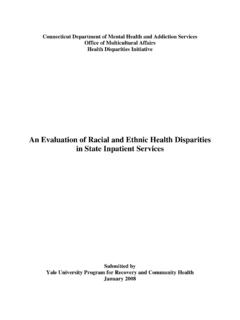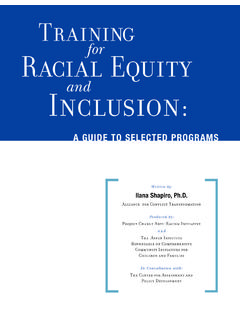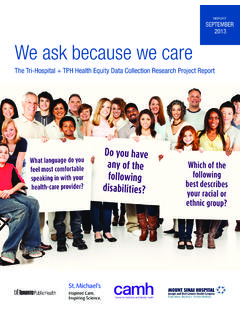Transcription of Structural Racism
1 Chronic Disparity: Strong and Pervasive Evidence of racial Inequalities POVERTY OUTCOMES Structural Racism By Keith Lawrence, Aspen Institute on Community Change and Terry Keleher, Applied Research Center at UC Berkeley For the Race and Public Policy Conference 2004 Structural Racism Definition: Structural Racism in the is the normalization and legitimization of an array of dynamics historical, cultural, institutional and interpersonal that routinely advantage whites while producing cumulative and chronic adverse outcomes for people of color. It is a system of hierarchy and inequity, primarily characterized by white supremacy the preferential treatment, privilege and power for white people at the expense of Black, Latino, Asian, Pacific Islander, Native American, Arab and other racially oppressed people. Scope: Structural Racism encompasses the entire system of white supremacy, diffused and infused in all aspects of society, including our history, culture, politics, economics and our entire social fabric.
2 Structural Racism is the most profound and pervasive form of Racism all other forms of Racism ( institutional, interpersonal, internalized, etc.) emerge from Structural Racism . Indicators/Manifestations: The key indicators of Structural Racism are inequalities in power, access, opportunities, treatment, and policy impacts and outcomes, whether they are intentional or not. Structural Racism is more difficult to locate in a particular institution because it involves the reinforcing effects of multiple institutions and cultural norms, past and present, continually producing new, and re-producing old forms of Racism . Individual Racism : Individual or internalized Racism lies within individuals. These are private manifestations of Racism that reside inside the individual. Examples include prejudice, xenophobia, internalized oppression and privilege, and beliefs about race influenced by the dominant culture.
3 Institutional Racism Institutional Racism occurs within and between institutions. Institutional Racism is discriminatory treatment, unfair policies and inequitable opportunities and impacts, based on race, produced and perpetuated by institutions (schools, mass media, etc.). Individuals within institutions take on the power of the institution when they act in ways that advantage and disadvantage people, based on race. Chronic Disparity: Strong and Pervasive Evidence of racial Inequalities POVERTY OUTCOMES Example: A police officer treats someone with racial bias, engages in institutional Racism , representing a law enforcement institution. racial Justice Definition: racial Justice is the proactive reinforcement of policies, practices, attitudes and actions that produce equitable power, access, opportunities, treatment, impacts and outcomes for all.
4 Indicators: Equitable impacts and outcome across race is the key indicator off racial justice. Interpersonal Racism : Interpersonal Racism occurs between individuals. Once private beliefs come into interaction with others, the Racism is now in the interpersonal realm. Examples include public expressions of racial prejudice, hate, bias and bigotry between individuals. Structural Racism Structural Racism lies underneath, all around and across society. It encompasses: (1) history, which lies underneath the surface, providing the foundation for white supremacy in this country. (2) culture, which exists all around our everyday lives, providing the normalization and replication of Racism and, (3) interconnected institutions and policies, they key relationships and rules across society providing the legitimacy and reinforcements to maintain and perpetuate Racism .
5 Examples include racist history, dominant cultural representations, popular myths, and compounded and chronic inequities, etc. racial Justice racial Justice Diversity (Diversity = Variety) racial Justice Equality (Equality = Sameness) racial Justice = Equity (Equity = Fairness, Justice) Chronic Disparity: Strong and Pervasive Evidence of racial Inequalities POVERTY OUTCOMES PL for a family of 4: $18,100 (Us Dept. of HHS, 2002) PATTERNS IN H & HOME OWNERSHIP AND ACCESS TO CREDIT For Individuals With The Same Incomes Source: Institute on Race and Poverty, 2000 0 10203040506070 Native AmericanBlack Non-HispanicAsian/Pacific IslanderLow Income (<200% PL)Poor(<PL)7822484546310102030405060708 0 Home Ownership RatesCredit Denial RatesWhitesBlacksHispanicsChronic Disparity: Strong and Pervasive Evidence of racial Inequalities POVERTY OUTCOMES Definitions and Descriptions of Racism WHITE SUPREMACY: White supremacy is an historically based, institutionally perpetuated system of exploitation and oppression of continents, nations and peoples of color by white peoples and nations of the European continent; for the purpose of maintaining and defending a system of wealth, power and privilege.
6 WHITE (as in white people ): The term white, referring to people, was created by Virginia slave owners and colonial rulers in the 17th century. It replaced terms like Christian and Englishman (sic) to distinguish European colonists from Africans and indigenous peoples. European colonial powers established white as a legal concept after Bacon s Rebellion in 1676 during which indentured servants of European and African descent had united against the colonial elite. The legal distinction of white separated the servant class on the basis of skin color and continental origin. The creation of white meant giving privileges to some, while denying them to others with the justification of biological and social inferiority. (Margo Adair & Sharon Powell, The Subjective Side of Politics. SF: 1988. ) WHITE PRIVILEGE: A privilege is a right, favor, advantage, immunity, specially granted to one individual or group, and withheld from another.
7 (Websters. Italics mine.) White privilege is an historically based, institutionally perpetuated system of: (1) Preferential prejudice for and treatment of white people based solely on their skin color and/or ancestral origin from Europe; and (2) Exemption from racial and/or national oppression based on skin color and/or ancestral origin from Africa, Asia, the Americas and the Arab world. institutions and culture (economic, legal, military, political, educational, entertainment, familial and religious) privilege peoples from Europe over peoples from the Americas, Africa, Asia and the Arab world. In a white supremacy system, white privilege and racial oppression are two sides of the same coin. White peoples were exempt from slavery, land grab and genocide, the first forms of white privilege (in the future US). (Virginia Harris and Trinity Ordo a, Developing Unity among Women of Color: Crossing the Barriers of Internalized Racism and Cross racial Hostility, in Making Face, Making Soul: Hacienda Caras.)
8 Edited by Gloria Anzald a. SF: Aunt Lute Press, 1990. p. 310). RACE: A specious classification of human beings created by Europeans (whites) which assigns human worth and social status using white as the model of humanity and the height of human achievement for the purpose of establishing and maintaining privilege and power. (Ronald Chisom and Michael Washington, Undoing Racism : A Philosophy of International Social Change. People s Institute Press. People s Institute for Survival and Beyond. 1444 North Johnson Street. New Orleans, Louisiana, 70116. 1997. Second Edition. p. 30 31.) Chronic Disparity: Strong and Pervasive Evidence of racial Inequalities POVERTY OUTCOMES PREJUDICE: A prejudice is a pre-judgment in favor of or against a person, a group, an event, an idea, or a thing. An action based on prejudgment is discrimination.
9 A negative prejudgment is often called a stereotype. An action based on a stereotype is called bigotry. (What distinguishes this group of terms from all the others on these two pages is that there is no power relationship necessarily implied or expressed by prejudice, discrimination, stereotype or bigotry. ) POWER: ( Power is a relational term. It can only be understood as a relationship between human beings in a specific historical, economic and social setting. It must be exercised to be visible.) 1. Power is control of, or access to, those institutions sanctioned by the state. (Definition by Barbara Major of People s Institute for Survival and Beyond, New Orleans) 2. Power is the ability to define reality and to convince other people that it is their definition. (Definition by Dr. Wade Nobles) 3. Power is ownership and control of the major resources of a state; and the capacity to make and enforce decisions based on this ownership and control; and (Alternative definition to #1) 4.
10 Power is the capacity of a group of people to decide what they want and to act in an organized way to get it. 5. (In terms of an individual), power is the capacity to act. Racism : Racism is race prejudice plus power. (Definition, by People s Institute. I use white supremacy as a synonym for Racism .) INTERNAUZED Racism : (1) The poison of Racism seeping into the psyches of people of color, until people of color believe about themselves what whites believe about them -- that they are inferior to whites; (2) The behavior of one person of color toward another that stems from this psychic poisoning. Often called inter- racial hostility; and (3) The acceptance by persons of color of Eurocentric values. (See Harris and Ordoira, op. cit. pp. 304 3 16.) REVERSE Racism : A term created and used by white people to deny their white privilege.









